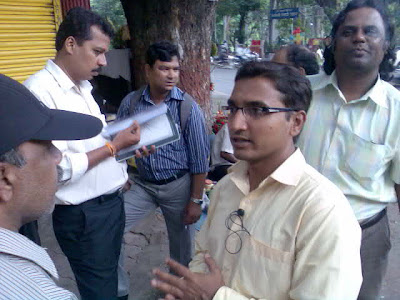Monday, 13 December 2010
Friday, 10 December 2010
Thursday, 9 December 2010
Tuesday, 7 December 2010
Movie Review: Khelein Hum Jee Jaan Sey: 'True Story' Luxuries
Ashutosh Gowariker is back to familiar territory with KHJJS, it has a similar 'Underdog vs Goliath' scenario as the entertaining Lagaan (2001). It also has, like the Oscar nominated movie, an impressive ensemble cast. Only, this one happened for real.
On April 18,1930, a band of young teenagers and revolutionaries led by Surjya Sen, (Abhishek Bachchan) a school teacher) attacked five main centres of British-ruled Chittagong (In undivided Bengal), in order to wrestle control and drive away the rulers, at least from their little sleepy town. Their plan was to capture all the ammunition and use it against the British themselves. What happened next? The film brims with the element of uncertainty many a time, a huge plus.
That Gowariker has no luxury of twisting fiction here (beyond a limit), acts to the film's advantage. The only causalities - Surjya comes off as a cardboard-dull person in the first half, rather than the quiet simmering patriot he is intended to be. Abhishek, acts well, has his moments, but doesn't bring out the fire of a person inspiring a large group of freedom fighters. The same can be said, to an extent, of Kalpana (Deepika Padukone), one of the two women who were part of the uprising, which is more to do with limited scope of the role. The rest of the cast are all very real, especially the young teenage actors who provide an unexpected punch to the proceedings.
Sohail Sen's music adds charm, his background score is understated, a charming ally to the proceedings. The title song rendition and depiction plays well as a upbeat musical transition, the same can't be said for Nayan tere - it makes for an awkward introduction to the female characters. Lip-synching of songs don't fit in in these settings.
KHJJS is original and poignant for most of its running time, the length is not a deterrent, as it was in Jodha Akbar (2008) and What's Your Rashee? (2009). As a viewer, I was disappointed by the lack of a powerful opening scene (Random shots of football playing kids), and the quiet introduction of Surjya Sen. Despite the flaws, this is a movie that burns slowly into our hearts. Yet, there is nothing extraordinary as we have come to expect from Gowariker.
Silent explosion
The noose around his neck, his mouth oozing blood, a man looks up as a full moon is ominously shrouded by clouds.
Movie Review:RAKTA CHARITRA II: Lost in Kill! Kill! Kill!
Stretched, a relentless bloodbath, a loud merciless background score (Dharam-Sandeep, the culprits), the overused slow motion technique, irritating upside down camera angles, and Ram Gopal Varma make up for a messed up second part of this movie - based as it on a true story. The politics of it is kept to the background, all we get to see is how revenge comes full circle for Pratap Ravi (Vivek Oberoi), as Surya (Tamil actor Suriya) has only one thing is mind - Ravi's death. Apparently, Ravi's men had killed off Surya's entire family in a murderous rampage of killing all potential enemies of Ravi.
Instead of effectively depicting how violence transmits - from a person's anger to a mass culture, what we get is an escapist orchestra of killings - bullet-holed bodies, vehicles in flames, and again the sickle. Some scenes work, like the tense slow-motion sequence of Surya's arrival at the court. Finally, at the end of it all Rakta Charitra makes a mild impact in its intended message. It certainly makes for gory, gritty drama but nothing more. The director's signature clad epilogue at the end says it all - it ends up making violence look more attractive and justified than deplorable.
Watch it strictly for the performances and RGV's technical expertise and experimentation, and the engaging cameos.
Friday, 3 December 2010
Thursday, 2 December 2010
Hamara Haiku Festival: Bhamburda Forest Clicks (Haiga)
HAIGA according to WIKIPEDIA
Haiga is a style of Japanese painting based on the aesthetics of haikai, from which haiku poetry derives, which often accompanied such poems in a single piece. Like the poetic forms it accompanied, haiga was based on simple, yet often profound, observations of the everyday world. Stephen Addiss points out that "since they are both created with the same brush and ink, adding an image to a haiku poem was... a natural activity."
Just as haiku often internally juxtapose two images, haiga may also contain a juxtaposition between the haiku itself and the art work. The art work does not necessarily directly represent the images presented in the haiku.
Though traditional-style haiga are still produced today, contemporary artists experiment with the form, coupling haiku with digital imagery, photography, and other media.
 |
bare bark stretches claws at green |
 |
winter the tree disrobes |
 |
dry stream the path curves, falls |
 |
 |
downhill dog can't apply the brakes |
HAIGA according to WIKIPEDIA
Haiga is a style of Japanese painting based on the aesthetics of haikai, from which haiku poetry derives, which often accompanied such poems in a single piece. Like the poetic forms it accompanied, haiga was based on simple, yet often profound, observations of the everyday world. Stephen Addiss points out that "since they are both created with the same brush and ink, adding an image to a haiku poem was... a natural activity."
Just as haiku often internally juxtapose two images, haiga may also contain a juxtaposition between the haiku itself and the art work. The art work does not necessarily directly represent the images presented in the haiku.
Though traditional-style haiga are still produced today, contemporary artists experiment with the form, coupling haiku with digital imagery, photography, and other media.
Subscribe to:
Comments (Atom)







